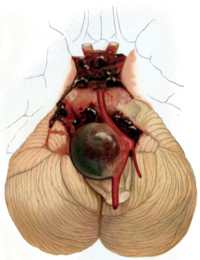
Photo from wikipedia
OBJECTIVE Rupture of unruptured intracranial aneurysms (UIA) is the main cause for subarachnoid hemorrhage (SAH). UIA are widespread among the population. Advanced technology enables us to diagnose UIAs with increasing… Click to show full abstract
OBJECTIVE Rupture of unruptured intracranial aneurysms (UIA) is the main cause for subarachnoid hemorrhage (SAH). UIA are widespread among the population. Advanced technology enables us to diagnose UIAs with increasing reliability and subsequently treat them. There are two main treatment options: surgical clipping and endovascular treatment of the aneurysm. This paper aims to analyze costs of neurosurgical clipping and the endovascular approach to treat UIA and to give an overview over the existing literature. METHODS A systematic literature search was conducted using the databases Ovid MEDLINE, Pubmed, and NHS EED. Articles were divided into two groups based on the perspective from which costs were evaluated (health care provider or payer). Costs were inflated to the year 2015 and converted to international Dollars. RESULTS The literature search yielded 137 different articles out of which 15 have been considered relevant and have been included in this review. Not only absolute numbers but also the cost ratio of both treatment modalities showed substantial variations. The coiling procedure tends to be more expensive for health care providers but cheaper for cost bearers. Without any exceptions, the authors determined shorter lengths of stay for patients who underwent the coiling procedure. CONCLUSIONS Due to different definitions of hospital costs and hardly reproducible calculations, comparability of the stated numbers is limited. Besides the economic impact, outcomes have to be taken into account, when making a treatment decision. The two treatment modalities are not equally suitable in every patient nor for every aneurysm location.
Journal Title: World neurosurgery
Year Published: 2019
Link to full text (if available)
Share on Social Media: Sign Up to like & get
recommendations!